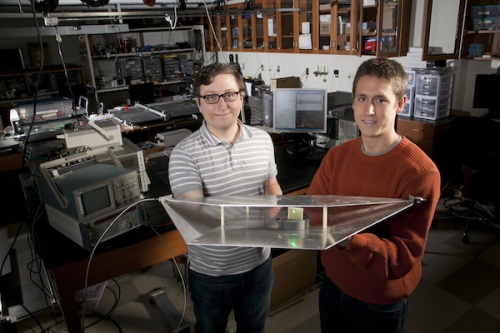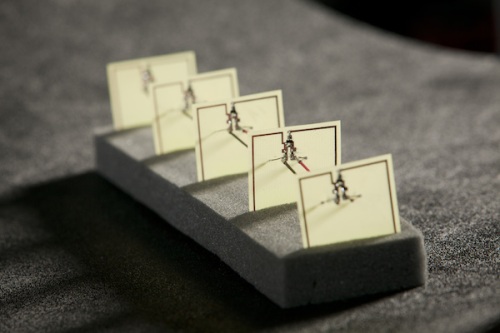Students at Duke University’s Pratt School of Engineering have developed a novel device capable of harvesting the signal from other energy sources, including satellite, sound, and even Wi-Fi signals, and turning it into usable power.

Undergrad Alexander Katko worked with graduate student Allen Hawkes on the device. Steven Cummer, the University’s professor electrical and computer engineering, acted as lead investigator and contributed to the design of the project.

Katko (left) and Hawkes (right) hold a waveguide that contains their power-harvesting metamaterial cell.
Their technology converts microwave signals to direct current voltages which, in turn, can be used to recharge items like one’s cell phone battery or other small electronic devices.
It’s made up of mostly inexpensive materials and operates with 36.8% efficiency — the same level as modern-day solar panels. The reason why it’s so efficient is because of the technology’s unique application of metamaterials — specially engineered structures designed to not only capture different forms of wave energy, but then tune them for useful applications.
Specifically, the trio used a series of five fiberglass and copper energy conductors wired together on a circuit board. Doing this allowed them to convert microwaves into 7.3V of electrical energy.
As the school’s press release points out, many of today’s USB chargers for small electronic devices provide approximately 5V of power.

The five-cell metamaterial solution developed by Duke engineers can convert stray microwave energy into more than 7 volts of power.
“We were aiming for the highest energy efficiency we could achieve,” said Hawkes. “We had been getting energy efficiency around 6 to 10 percent, but with this design we were able to dramatically improve energy conversion to 37 percent, which is comparable to what is achieved in solar cells.”
“It’s possible to use this design for a lot of different frequencies and types of energy, including vibration and sound energy harvesting,” Katko said. “Until now, a lot of work with metamaterials has been theoretical. We are showing that with a little work, these materials can be useful for consumer applications.”
Here’s a good for instance on how this sort of thinking could be worked into everyday life: metamaterials could be applied to the walls and ceilings of a room in order to redirect and recover Wi-Fi signals that would otherwise be lost.
Another application would be to improve the energy efficiency of today’s appliances by wirelessly recovering power that’s currently being lost during use.
“The properties of metamaterials allow for design flexibility not possible with ordinary devices like antennas,” said Katko. “When traditional antennas are close to each other in space they talk to each other and interfere with each other’s operation. The design process used to create our metamaterial array takes these effects into account, allowing the cells to work together.”
Looking ahead, the team hopes to one day see their solution incorporated into the design of cell phones, so that the phone could recharge wirelessly while not in use. Beyond being a matter of convenience, this would also allow people living in remote locations without ready access to power stations to harvest energy from a nearby cell phone tower instead.
“Our work demonstrates a simple and inexpensive approach to electromagnetic power harvesting,” said Cummer. “The beauty of the design is that the basic building blocks are self-contained and additive. One can simply assemble more blocks to increase the scavenged power.”
The group’s work appears in the December 2013 issue of Applied Physics Letters. It is available online for purchase.
Story via: pratt.duke.edu
Advertisement
Learn more about Electronic Products Magazine





